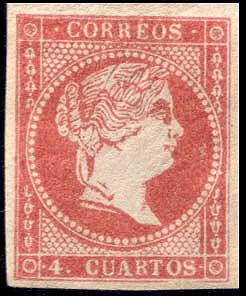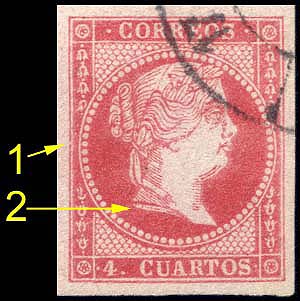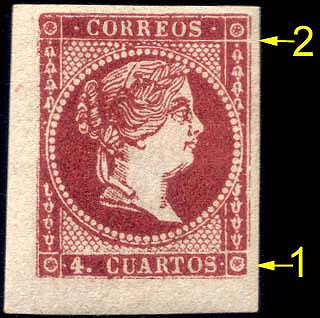<< Back
The 4 cuarto of 1856-59
- the 3 types.
 You might be asking yourself
"why is he devoting a whole page to one of the single
most common 19th century stamps of Spain?"
Well, aside from the fact that
it is one of my favorite issues, ugly as it is, it seems to be
one of those issues that is not understood by the average collector
nor is it understood very well by the Scott catalog. Since most
of the collectors and dealers in the United States use the Scott
catalog, this might be especially helpful to them. This page
is going to deal with the unwatermarked variety only, as this
seems to be where the confusion is.
Note: If anyone can add or
correct any of the information on this page, let me know. rbpuzzles@webound.com
Let's start with some facts:
You might be asking yourself
"why is he devoting a whole page to one of the single
most common 19th century stamps of Spain?"
Well, aside from the fact that
it is one of my favorite issues, ugly as it is, it seems to be
one of those issues that is not understood by the average collector
nor is it understood very well by the Scott catalog. Since most
of the collectors and dealers in the United States use the Scott
catalog, this might be especially helpful to them. This page
is going to deal with the unwatermarked variety only, as this
seems to be where the confusion is.
Note: If anyone can add or
correct any of the information on this page, let me know. rbpuzzles@webound.com
Let's start with some facts:
- Issued on April 11, 1856, valid until
February 15, 1860
- Typographed in shades of red, rose
and carmine on white, unwatermarked paper
- Design = 20 x 24mm
- Printed in sheets of 100 or 170 stamps
- There are 13 different postal forgeries
known to exist
- There are 3 distinctly different types,
none of which are noted in Scott's catalog but are very often
misidentified. It could be very beneficial to know the difference
because some are very difficult to find and are sought after.
Now, let's get into some detail
here and look at each type individually.
Type I (Edifil
#48, Scott #45)

Click
here to see an unused block of 8 of
this type
This type is by far the most
common one you will run into. It is usually in shades of red.
It was the first type issued in 1856 and was in production for
most of the issuing period (exact date not known, but probably
into 1859), with a large quantity printed (not known to me, but
probably in the 7-figure range). There are many plate and printing
flaws that can be found here, as well as shades of color. A large
percentage of copies seem to be dull in color and lack a crispness
to the design, this is especially evident in the lines of shading
on the neck and throat and around the eye (compare with the images
of the other 2 types). This type is valued higher in unused condition
than used for the simple fact that a high percentage of the issued
stamps were actually used.
Type II (Edifil
#48A, Scott - unlisted)

Click
here to see a block of 4 of this type
Now, let's look at type II.
Accordoing to the Edifil catalog, this type was issued sometime
in 1859. It is printed in more of a rose color, rather than the
reds of T.I. There are 2 main differences in this type, as compared
to the previous type. 1.) There is a small break in the
left side outer frame line, just about midway up. 2.)
The white narrow space at the base of the bust has been made
wider and there is a row of small colored dots running down the
middle of it. This type, at least the ones I have in my possession
and seen elsewhere, has a fineness to the printing. I attribute
this to the fact that it was printed late in the validity period,
from new plates, and the plate did not have the chance to get
very worn.
Type III (Edifil
#48B, Scott #45a)

Click
here to see a block of 25 of this type
This one is where most people
tend to misidentify. According to the Edifil catalog, this one
was also issued in 1859, same as type II, but I believe it was
issued towards the end of that year. It is usually found in a
darker more carmine color. There are some very distinct characteristics
to this type. 1.) There is usually heavy breaking in the outer
frame lines. 2.) There is a constant break in the right outer
frame line just below the top of the design next to the upper
right corner ornament. 3.) The printing is almost invariably
heavier, and on some very clear. I believe this is a result of
using acid-cleaned plates. Since this type was issued so late,
there probably were not very many used, which would account for
the high percentage of copies found in unused condition. I have
also been told that alot of remainders did not recieve the standard
3-bar remainder cancel. postally used copies are valued at a
premium over unused. This is where things get weird. The Edifil
has this type priced correctly but Scott's has chosen to list
them incorrectly. And since most US dealers use Scott, they almost
always have them listed incorrectly in there sales. It seems
that the majority of unused copies being advertised for sale,
turn out to be type III.
Check your copies, you might
be the lucky owner of one of the better types.


